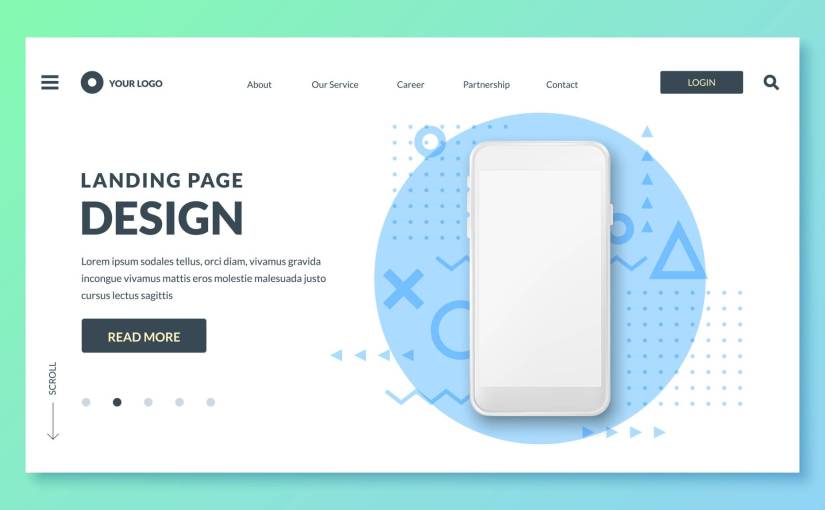How to Create a High-Converting Product Landing Page
Business leaders and marketers across all industries want nothing more than to connect with their readers and grow their brands. However, they face many challenges along the way. One of the biggest hurdles is convincing users to invest in...

Business leaders and marketers across all industries want nothing more than to connect with their readers and grow their brands. However, they face many challenges along the way. One of the biggest hurdles is convincing users to invest in a product or service. The simplified solution is to build engaging product landing pages.
The thing is, not all landing pages are created equal. You have to know how and when to connect with customers if you want to find success.
Technology has changed the digital marketing landscape forever. We now have more ways than ever before to communicate company and product benefits. Marketers can improve on-site engagement and sales when they use the tools they have at their disposal.
Now, let’s dive in and look at several actionable ways you can use tech to create high-converting product landing pages.
 Product Landing Page Plan on Paper
Product Landing Page Plan on PaperShow Relevant Lead Magnets
Lead magnets are one of the best things you can do with your product landing page. Simply put, these are exclusive content and offers designed to generate leads and provide value to readers.
Common examples of lead magnets include:
Discounts Case Studies Infographics Event InvitationsThese offers are crucial for improving conversions because, on average, 40-70% of qualified leads are not ready to buy. If a customer leaves without interacting with your brand in a meaningful way, they will likely forget it exists.
On the other hand, if a user joins your email list, you have a direct line to stay in touch and build rapport through lead nurturing.
The key to getting people to click a lead magnet is to offer something the reader will find valuable. This concept will vary based on the intended audience. Segmenting visitors based on their unique interests, goals, and pain points can help you come up with inventive and effective lead magnets.
There are plenty of different lead-generation plugins that allow users to create attractive and engaging offers for product landing pages.
Make Mobile-Friendly Product Landing Pages
Google has made it clear that they want business leaders to optimize their websites for mobile. When you consider that over 68% (smachballoon dotcom) of the global population owns a mobile device, this shouldn’t come as a surprise.
Online shoppers use smartphones and tablets to engage with brands, read reviews, and shop. Mobile apps are on the rise that allows consumers to do all of this and more. If your website or app, including your landing pages, is not optimized for mobile, you could miss out on significant traffic and clicks.
There are many ways to ensure your site is ready for mobile users. Here are a few tips to keep in mind:
Use a landing page builder that comes with mobile templates. Reduce the size of images and host videos off-site for faster loading times. Make sure buttons and navigation work with handheld devices. Test your product landing page with multiple operating systems and devices.You’ll find that putting smartphone users first in terms of page design and functionality can lead to a tremendous boost in conversions.
Optimize for Voice Search
While we are on the topic of mobile devices, let’s talk about voice search. Did you know that around 30% (pushengage dot com) of all searches were conducted without a screen last year? In other words, people use smart speaker devices or voice assistant apps on their smartphones and computers to search for websites, information, and products.
 Person Using a Smartphone Voice Assistant
Person Using a Smartphone Voice AssistantWebsites not optimized for what a customer might say have a slim chance of appearing in the results for these types of searches. The good news is you can start making changes today to make your landing pages voice search-friendly.
We suggest including FAQs at the bottom of each product page. This seemingly small addition can significantly impact how people engage with your brand.
At face value, an FAQ section answers vital questions asked by your target audience. The option to see these questions and answers can guide users and help them determine if your product or service is right for them.
Behind the scenes, FAQs can help build your search presence, particularly when it comes to voice search. When someone uses voice search, they typically ask a question. If your landing page answers their inquiry in a concise and accurate way, Google may relay the answer you provided to the user.
You can also appear in the featured snippets at the top of Google for specific keyword searches. It’s worth mentioning that over 40% of voice results come from featured snippets.
It’s also a good idea to add schema markup to your website. Schema markup is behind-the-scenes code that allows Google to better understand your intent. Marketers use this SEO strategy to inform Google about product availability, prices, and more.
The bottom line is this; if you want to attract more visitors to your landing page, even if they aren’t using a screen, voice search optimization is a must.
Focus on User Benefits
A fundamental mistake many business owners make when designing their product landing pages is they spend too much time focusing on features instead of benefits. The two ideas are similar but differ in one important way.
Features are what your products can do. Benefits describe how features will ultimately help the end user. For example, a social media marketing plugin might promote a feature called a social wall. Most potential customers, even those skilled in social media marketing, will wonder exactly what they mean and why they should care.
Now, imagine if, instead of promoting a social wall feature, the company stated that this feature allows people to share all of their social media feeds in one place, which can boost brand awareness.
The second description is more detailed and explicitly tells users how they will benefit from this feature.
When designing your product landing pages, keep your customers’ needs in mind. Instead of writing a bullet list of features like you’re in an investor call, spend some time thinking about your product from your customer’s eyes. Write benefit-oriented descriptions, and people are far more likely to engage with your business.
Show Social Proof
Social proof is an excellent way to improve your landing page conversion rate. If you’re unfamiliar with the concept, social proof is a psychological phenomenon that causes people to do things based on other people’s experiences. We all tend to trust people and businesses that are respected by others.
The most common type of proof is user reviews. Think about the last time you bought something from Amazon. There’s a good chance you scrolled to the bottom of the page to learn what other people thought of the product.
If you saw only 1-star reviews, you likely decided to pass and look for a similar product with better reviews. Similarly, a bunch of 5-star reviews may have prompted you to place an order.
Research shows that user reviews and other types of social proof can have a noticeable impact on conversions. In fact, surveys suggest that 83% (trustpulse dotcom) of people trust customer reviews over traditional advertising.
There are two primary ways to add reviews to your landing page. The first method involves placing an open-ended review form on your page, just like Amazon. Customers can review your products, and future visitors can see how others feel about your brand.
The other way to show reviews is to pull positive feedback from social media and surveys. You could include a section on the product page that reads, “see what others think of (product)!” A few glowing reviews can turn a prospect who is on the fence into a happy, paying customer.
You can also use live sales notifications and trust seals to capture visitors’ attention and convince them to take action.
Split Test Product Landing Pages
Much like the rest of your website, your product landing pages need to evolve with the needs of your customers. Split tests are a great way to experiment with new ideas and improve clicks.
Split tests, also known as A/B tests, involve changing a page, email, or social media marketing campaign for 50% of your audience. These changes can be subtle, like switching the verbiage on a call-to-action, or they can be something more noticeable, like a complete color swap.
 A/B Test Example
A/B Test Example The objective of split testing is to see which version of the page leads to more clicks and sales.
Let’s say a marketing team decides to test their call-to-action by changing “subscribe now” to “subscribe and save.” After enough time has passed – we suggest two weeks to a month for each test – they look at the results.
If the subscribe and save option saw significantly more clicks, the team may use this new call-to-action on pages they want to improve.
It’s possible to test many different aspects of your pages, but it’s worth mentioning that tracking one test per page is the best option. Multiple tests make it hard to determine what led to better (or worse) results.
Final Thoughts
Online businesses need product landing pages to generate leads, sales, and interest in their brand. Every industry is different, so it’s always a good idea to introduce new strategies slowly so you can figure out what works.
The tips presented today will help steer your product landing page in the right direction. The tools and resources you need to improve performance and connect with more customers are out there. The only thing left to do is get started.
Featured Image Credit: Provided by the Author; Thank you!
![]()
Syed Balkhi
Syed Balkhi is the founder of WPBeginner, the largest free WordPress resource site. With over 10 years of experience, he’s the leading WordPress expert in the industry.

 Fransebas
Fransebas 
































